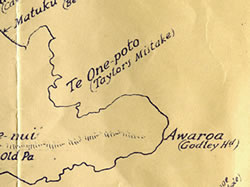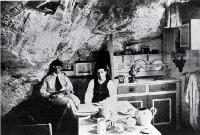A page on the history of Christchurch landmark Taylor’s Mistake by librarian Damian Cairns, now Curator of Pictorial Collections at the Canterbury Museum.
The Naming of the Bay
![Photo of The beach and holiday baches at Taylor’s Mistake [193-?]](https://christchurchcitylibraries.com/heritage/photos/disc10/thumbnails/img0080.jpg)
The name Taylor’s Mistake is most commonly attributed to a Captain Taylor of the Volga. In 1858 Taylor beached the American ship in the bay. He also mistook the bay’s identity. Sources are split, with some suggesting Sumner and others pointing to Lyttelton Harbour as Taylor’s intended destination.
While the origin of the name seems obvious, but six years later a second Captain Taylor was guilty of a navigational mistake in the bay. In 1864 the schooner Catherine also ran aground at Taylor’s Mistake. Although the Volga incident is still widely credited to be the story behind the name, neither this story nor the later case of the Catherine are likely to have inspired it.
This is because the name Taylor’s Mistake appears earlier than either of these maritime incidents. According to the 1941 title Sumner, the bay was known as Taylor’s Mistake as early as 1853. This publication was written by the then Town Clerk of the Sumner Borough Council, J. F. Menzies, who cites the Southern Provinces Almanac and its reference to Vincent’s Bay or Taylor’s Mistake.
After discounting the Volga story, Menzies notes that the barque Gwalior arrived at Lyttelton in April 1853. Captain Davidson, commander of the barque when it left England on its 200 day journey to Auckland, threw himself overboard on 16 April, and Mr Taylor, Chief Officer, took command, and brought the barque to Lyttelton. He may have been anchored off Taylor’s Mistake. There seems to be more to the story than that which Menzies has outlined here and this led the author of the Guardians of the Mistake to note the precise background to the naming of Taylor’s Mistake will probably elude any historian.

Cave dwellers
There is no known Māori settlement of Taylor’s Mistake, although it is known as Te Onepoto (Short Beach). As with other bays in the area, it would have been used for food gathering and shelter by local Māori.
It was used by early European settlers for the same purpose. Recreational fishermen would spend the weekend in the caves. The natural shelter of the many caves in the bay enabled the visitors to stay without having to face the walk back home after fishing all day.
The first permanent settlement in the bay was established by Christchurch painter Tom Archbold in 1879. This settlement was to the south of Taylor’s Mistake not far from Boulder Bay.
An engraver by the name of A.P. Osborn (commonly mis-spelt Osborne) was the second person to establish a property within the caves of Taylor’s. He built just north of Archbold’s dwelling and even established a telephone link of sorts between the two properties using lemonade bottles as insulators. Known as The Pilgrim, he was to become one of the most well known figures in the bay, as well as a founding member of the Surf Club. Pilgrims Rest as his property was known, became a popular spot for visitors, but this popularity required Osborn to continually work on the track to provide safer access. It is believed that he worked on the track for over 20 years.
![Photo of The front of Hobson’s cave house [1910]](https://christchurchcitylibraries.com/heritage/photos/disc5/thumbnails/img0042.jpg)
Today the only remaining cave dwelling in the area is Hobson’s Cave, also known as Whare Moki. This cave in Hobson’s Bay has been modified extensively by its many owners and has been susceptible to damage from storms.
The Baches
Taylor’s Mistake is also known for the issue of baches located on the Queen’s Chain. The first of these baches built on what is know as Rotten Row was built in 1913 by Bill Stevens. Stevens’ motivation for building a more solid structure was due to a stampede of cattle that destroyed his tent one evening while on one of his many rabbiting trips to the bay. Most of the other baches built behind the beach on the Row were constructed in the 1930s.
It was reported on 11 March 2011 that the old baches survived the earthquakes almost unscathed
.
The Howard Mystery

On 16 December 1885, at Taylor’s Mistake, a bay already clouded in mystery and maritime drama, a hand was found by two men fishing off the rocks. Identified by a ring still on it, the hand was claimed by a Mrs Sarah Howard as being that of her husband. Mr Arthur Howard’s clothing had been found on Sumner beach on 11 October the same year. Mr Howard, who was a mechanic had life insurance to the value of ₤2,400 - a considerable amount of money for this time. The sum Mrs Howard stood to gain from her husband’s demise, as well as several other aspects of the case, raised police suspicions. This led to the two fishermen and Mrs Howard being arrested for conspiracy to defraud an insurance company. Mr Howard was later tracked down in Petone, at a YMCA picnic (both hands intact) and was arrested.
The hand was later identified as that of a woman but despite the exhumation of several graves in an attempt to discover the hand’s owner, to this day the identity of the woman is not known.
Taylor’s Mistake resources
- Search our catalogue for information on Taylor’s Mistake
- Search Papers Past for historical articles on Taylor’s Mistake
- Taylors surfcam

Sources
- Summer on the edge, The Press, 12 January 2008.
- Articles about Taylor’s Mistake baches
- John F. Menzies Sumner. Christchurch: Simpson & Williams, 1941.
- Ray Cairns. Guardians of the Mistake : the history of the Taylor’s Mistake Surf Lifesaving Club, 1916-1991. Christchurch: The Club, c1991.
- The severed hand; or, The Howard mystery : with portraits of Mr and Mrs Howard, the Messrs Godfrey, and the mysterious hand. Christchurch: Capper Press, 1974.
- Carl Walrond. Beachcombing, Te Ara - the Encyclopaedia of New Zealand, updated 24-Sep-11
- Gordon Ogilvie. The Port Hills of Christchurch. Wellington: Reed, c1978.
